Dueling Kashmir narratives on social media, part 2: India
Indian and Pakistani users amplified misleading content on social media in the wake of Kashmir digital blackout
Dueling Kashmir narratives on social media, part 2: India
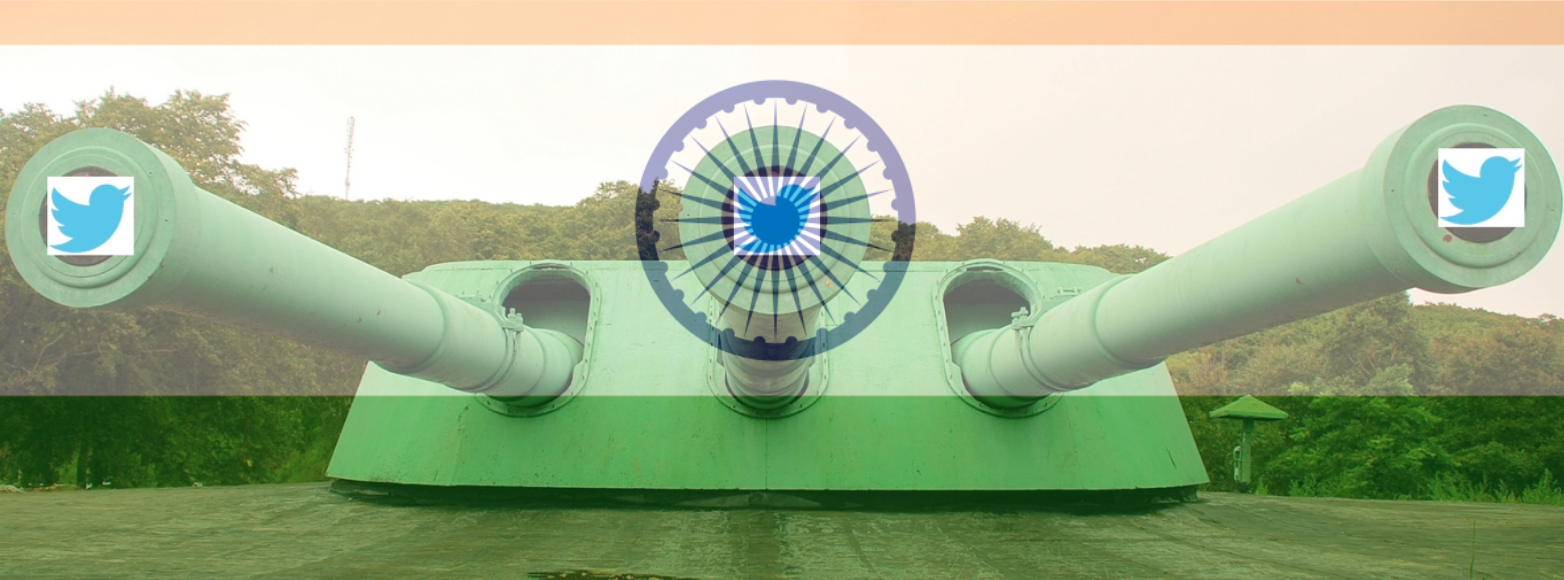
BANNER: (Source: @DfrKaul/DFRLab, @disinformediain/DFRLab via Unsplash and Bannersnack)
This is the second of a two-part series looking at the use of social media in India and Pakistan in the aftermath of India’s digital blackout in Kashmir.
As seven million Kashmiris found themselves cut off from the outside world, Indian users in the rest of the country and Pakistani social media users took to Facebook and Twitter to share misleading content in a bid to manipulate public perception regarding developments on the ground.
Part 1 looked at how Pakistani users misrepresented old and edited videos in an effort to highlight alleged human rights violations committed by Indian security forces against local protesters. In Part 2, the DFRLab chronicles how Indian users disseminated misleading content that downplayed reports of violent unrest in the state and characterized the local Kashmiri population living under the Pakistan-administered portion of the contested territory as revolting against Islamabad’s rule.
The Indian government’s decision — at the direction of Prime Minister Narendra Modi and his Bharatiya Janata Party (BJP) — to sever Kashmir’s connection to the rest of the country has complicated daily life for locals in Kashmir. The New York Times reported the manner in which Kashmiris were forced to cope with understocked pharmacies, cash shortages at ATMs, panic-stricken relatives unable to contact their loved ones, and shuttered grocery stores. In early September, Rohit Kansal, a senior Indian government official, claimed that most of the restrictions had been lifted, leaving “93 percent of Jammu and Kashmir, and Ladakh free from any prohibitory orders.” Local media outlets, however, have continued to report on the hurdles faced by residents in their daily life, with markets remaining shut and public transport still suspended since the shutdown.
The Indian narrative — business as usual
Three days after diluting the constitutional provisions governing Kashmir’s autonomy and imposing a communications blackout in the state, Prime Minister Modi gave a public address in which he called his government’s actions a “historic decision” that would allow Kashmir to integrate with the rest of India, bringing greater economic opportunity to the locals. Modi also attempted to assuage concerns over escalating tensions in the state but omitted discussion of the harsh restrictions the Indian government has imposed on life in Kashmir.
Shortly after Modi’s public address, two major Indian publications, Asian News International (ANI) and India Today, ran misleading stories supported by photographs that showed Indian Muslims conducting their Eid prayers at a mosque in Jammu. Rajat Sharma, Editor-in-Chief at India TV, also amplified the misleading narratives.
These misleading news reports portrayed the Eid al-Adha celebrations on August 12 in Jammu and Kashmir — considered to be a single state by the Indian government — had been conducted freely. In contrast to the Hindu-majority Jammu region where the government restrictions regarding public assembly had been eased prior to Eid, however, large parts of the Muslim-majority Kashmir valley, including its largest city of Srinagar, remained under curfew on the day of the Islamic holiday. Indeed, the Times of India reported on the diminished attendance at various Eid gatherings in Srinagar that day, contradicting the misleading narrative disseminated by other mainstream local media outlets.
ANI, a major domestic publication with three million followers on Twitter, also posted the photos of Indian Muslims praying at a mosque in Jammu and claimed they showed people celebrating Eid at local mosques in “various parts of the city” of Srinagar, despite the fact that Srinagar is not in the district of Jammu.
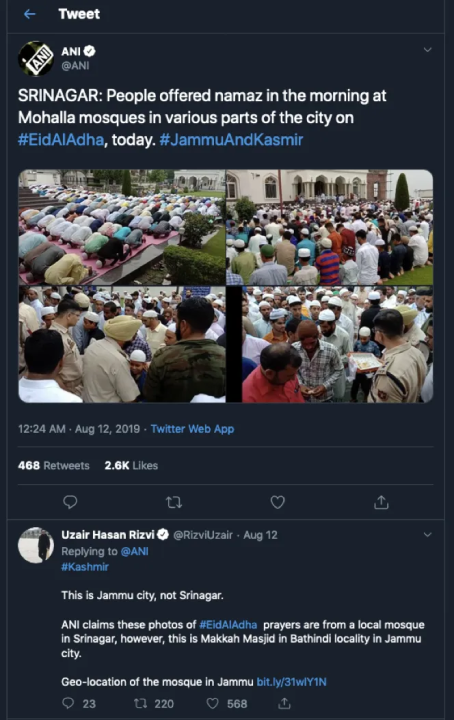
Uzair Hasan Rizvi, a journalist with the French news agency AFP, quickly pointed out the error via a reply to ANI’s original story. He noted that the photos being used to support the narrative actually showed the Eid celebrations in Jammu City instead of Srinagar. This clarification, however, received less engagement than the original post sharing the misleading content, only managing to accrue 220 retweets and 568 likes as of September 19, in comparison to the original tweet’s 468 retweets and more than 2,600 likes.
The misleading photographs were also debunked by AltNews, a local fact-checking outlet that published analysis confirming that the façade of the mosque shown in ANI’s story was that of the Makkah Masjid in Jammu City, thereby indicating that the major publications had incorrectly conveyed that the photographs showed locals in Srinagar.
The same misleading photographs were also published by India Today in a story on locals in the city of Srinagar celebrating Eid. CrowdTangle analysis of this article showed that it had gained 163 interactions, a slight majority of which took place on Facebook. Despite the low engagement for this article, the publication itself has nearly 10 million followers on Facebook.
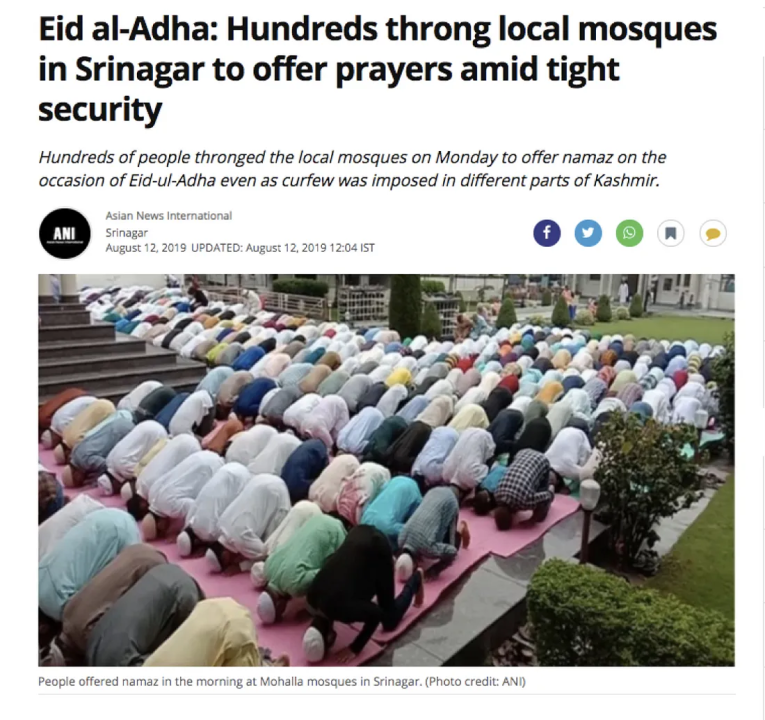


Finally, Rajat Sharma, India TV’s Editor-in-Chief, uploaded a tweet with the same misleading photographs taken by ANI, captioning the photographs as representing Eid “celebrated peacefully this morning in Srinagar.” Sharma’s account has over 3 million followers, making it a significant amplifier of the misleading content.
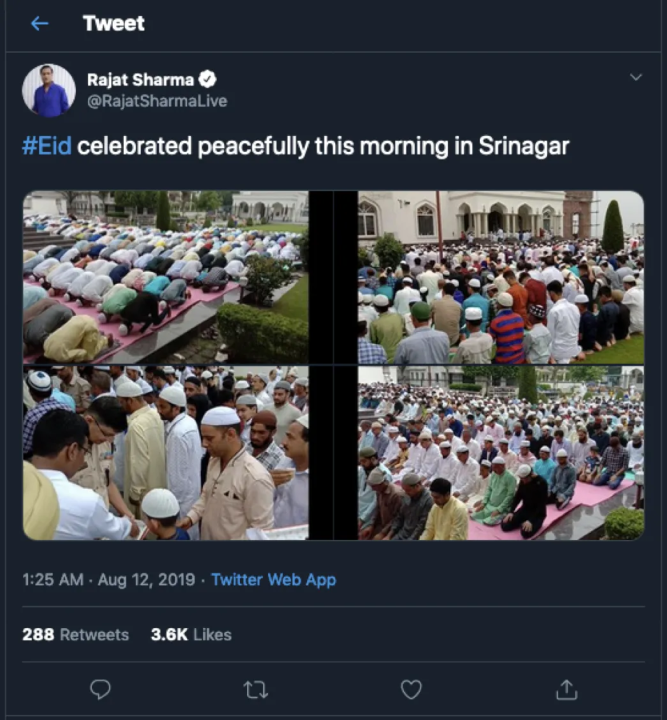
A day later, AltNews founder Pratik Sinha uploaded a post debunking Sharma’s misleading tweet. In his post, Sinha claimed that Sharma still had not corrected his tweet, despite Sinha drawing Sharma’s attention to the error many times. This clarification gained more traction than the other examples provided in this analysis, accruing 1,300 retweets and 3,100 likes. Despite the traction gained by Sinha’s post, Sharma’s original post furthering the misleading content had not been taken down at the time of publication.
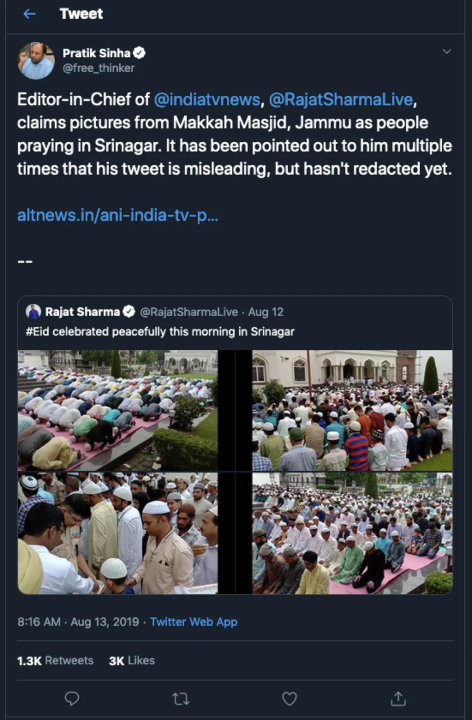
Indians respond to Pakistani rhetoric
To counter anti-Indian government rhetoric disseminated by a subset of Pakistani social media users, some Indian users attempted to highlight popular protests by Kashmiri Muslims in Pakistan-administered Kashmir. They claimed these recent demonstrations were triggered by disenchantment with Islamabad’s rule and a desire to join the Indian-administered part of Kashmir following the BJP’s sweeping constitutional amendments to the state.
To further this narrative, users shared a video that showed a group of Muslim men burning a Pakistani flag chanting “Pakistan Murdabad” (“Down with Pakistan”), claiming that this represented “Hundreds of thousands of Kashmiris” in Pakistan-administered Kashmir demonstrating against Pakistani rule.
Twitter account @umagarghi, whose profile features an Indian flag and describes its operator as a “Proud Hindu,” uploaded a video on August 12 that allegedly showed a large protest by Kashmiri Muslims against Pakistani rule. The caption also alleged that locals had requested her to “spread the video all over the world as the Indian media did not cover such a huge rally.” At the time of archiving, the video had accumulated more than 17,000 views. The tweet has since been removed.
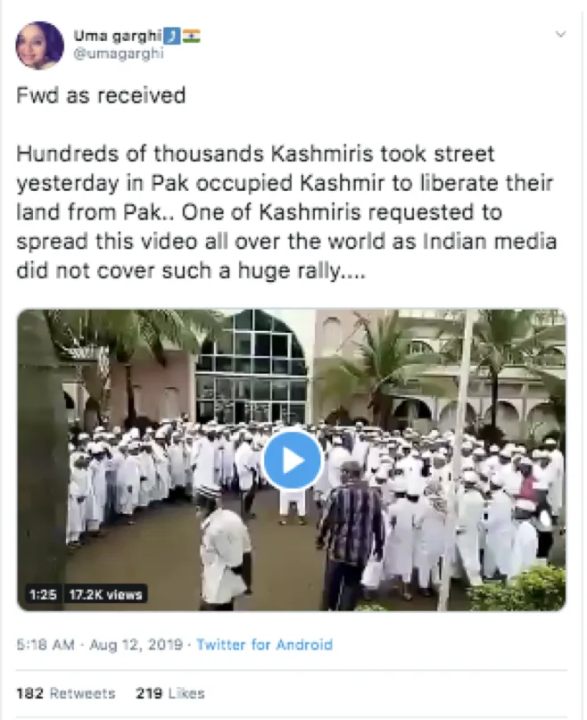
The video and the claim that it represented a recent protest by locals was debunked by BoomLive, a domestic fact-checking outlet. BoomLive reverse image-searched frames from the video and determined that it was from a protest that had taken place in 2016. While the outlet was unable to confirm the location of the protest, the age of the video alone made any use in reference to the August blackout and associated protests to be an instance of misinformation at best.
Despite this clarification, a week later an anonymous account with the handle @Eagleeye47 amplified the video with the same misleading claim, asserting that the video showed that locals “want to unite with their free Kashmiri brothers and sisters now.” At the time of archiving, the video had accumulated more than 19,000 views.
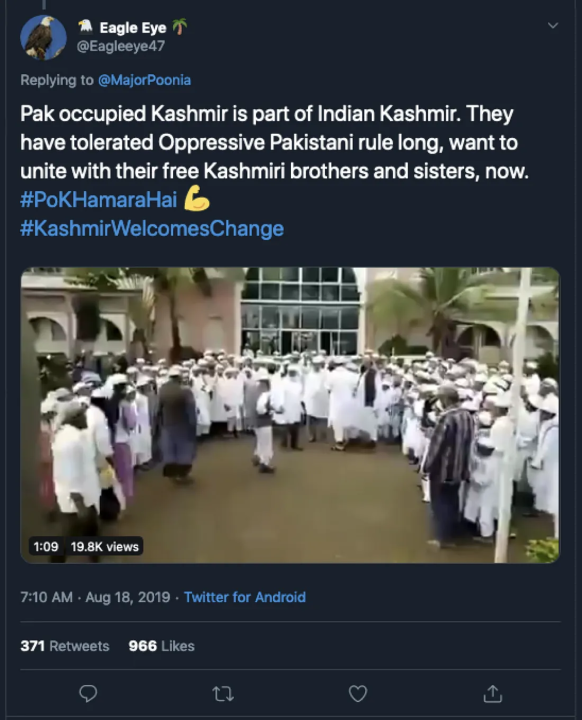
Conclusion
The blackout in Kashmir created an information vacuum that obscured the extent, or lack thereof, of popular unrest in the state, the inability to congregate publicly or utilize communication platforms also prevented outside observers from gauging the true reaction of the locals to the government’s decision. With local Kashmiri opinions obstructed from view, those seeking to gain a better understanding of the picture on the ground were exposed to false narratives furthered by social media accounts in the rest of India and Pakistan.
The high engagement garnered by the misleading photos and videos on social media during the digital blackout of Kashmir indicated that, in similar situations, malicious actors can exploit information vacuums as a means of influencing the discussion toward their own pernicious ends.
Follow along for more in-depth analysis from our #DigitalSherlocks.

